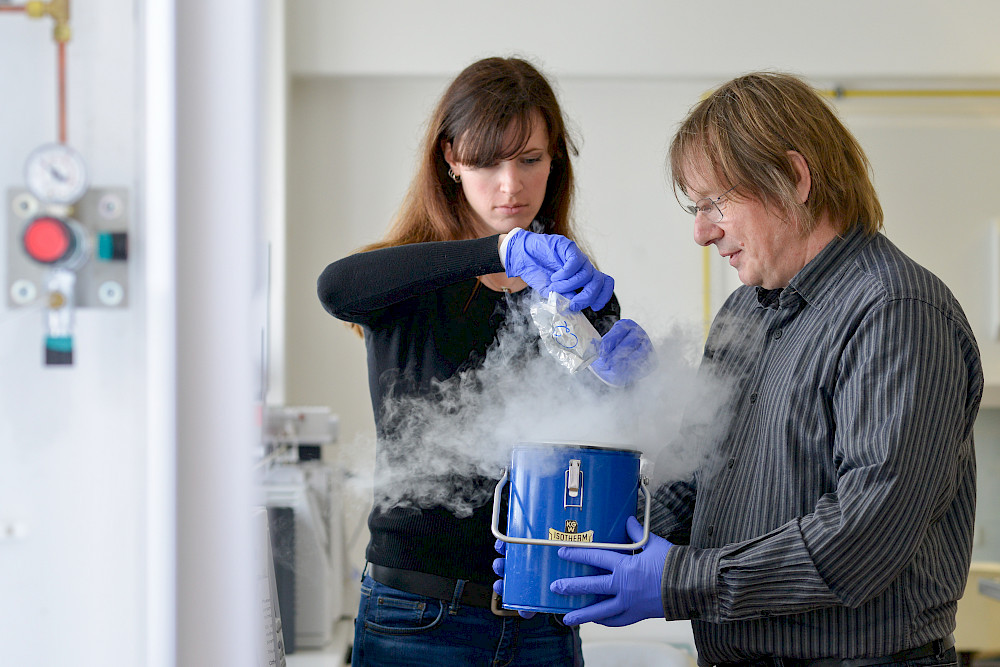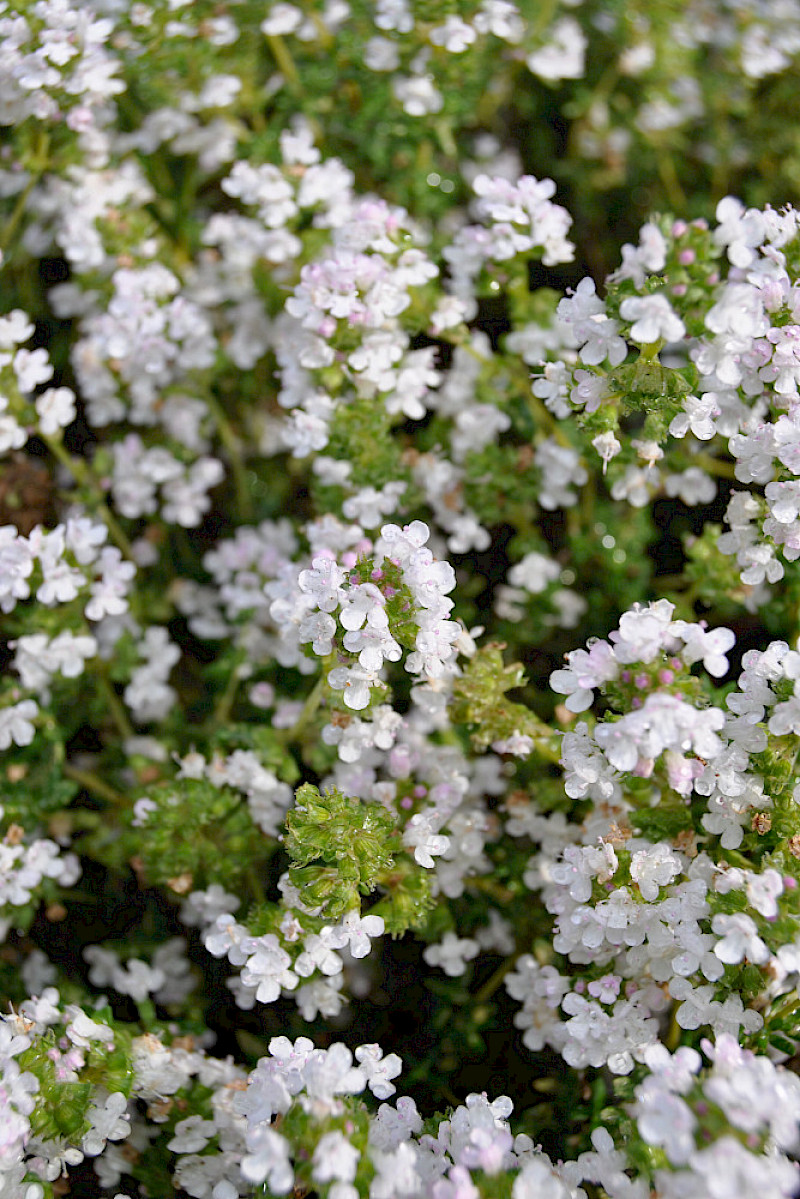The scent of science

If you visit the Institute of Pharmacy at the University of Halle, you will see six different types of thyme growing in a small flowerbed in front of the building. It could hardly be a more inhospitable place – the sun relentlessly beats down on the dry plants, there is hardly any shade, and the flowerbed is situated in a wind corridor. However: “The plants grow better here than in the greenhouse”, says Professor Jörg Degenhardt, who is heading the Pharmaceutical Biotechnology research group at the MLU. He plucks some flowers from a thyme plant, rubs them between his fingers and smells them. “This type produces a fragrance known as linalool, a terpene with a citrus scent”, he says. The researcher recognises all six plant types by their smell: from fruity to medicinal or even with a hint of sage. In early summer, the researchers take samples from the flowering plants and freeze them in liquid nitrogen to preserve them for their research.
The plants were originally sourced from the Montpellier region in the south of France – a few of them were sent on a 1,300-kilometre journey to Halle over ten years ago. “I’m fascinated by the plants’ genetics”, says biochemist Degenhardt. He explains that thyme is an epistatic series – all six types cultivated at the institute have the same genetic material and the same appearance. But they activate their genes differently, which changes the aroma of the plants. Degenhardt wants to understand how this genetic regulation works.
Plants put up a fight
He is particularly interested in the production of “secondary metabolites”, i.e. a group of chemical compounds that are formed by plants but, unlike carbohydrates, proteins and fats, are not essential to their existence. They are a sort of evolutionary upgrade that makes plants better adapted to their habitat, which they can’t just leave when conditions become adverse. For example, plants use secondary metabolism to produce substances that provide protection against predators. Lemon thyme produces linalool, which prevents the plant from becoming infested with snails and gives the plant its characteristic fruity scent.
Degenhardt’s research group has been focusing specifically on the substances thymol and carvacrol, which are contained in the essential oils of thyme, as well as in oregano and other plants in the mint family. Both substances are responsible for the distinctive scent exuded by the plants. “Thymol, which is mainly obtained from thyme, can loosen respiratory secretions and has antibacterial and antispasmodic properties. That’s why the plant is often used in teas, cough syrup and herbal medicines to treat bronchitis”, explains Degenhardt. Oregano contains a large amount of carvacrol, which has similar properties. Its scent is often associated with pizza sauce and other Mediterranean dishes. From a chemical point of view, both are closely related substances.
They are both formed in a multi-stage process that is similar to a factory assembly line. Degenhardt: “Every step of the process is coordinated and the desired product is only ever created in the right order”. In this process, the machines are special biomolecules – enzymes – that work in the glandular cells on the surface of the plant’s leaves. The raw material is always the same and, depending on the type of thyme, it is processed in such a way that secondary metabolites are produced in different quantities.
Old mystery solved
A couple of US researchers, Ayrookaram Poulose and Rodney Croteau, proposed a molecular pathway for this process as early as 1978. However, it had a few weak points: “They assumed that the substance p-cymene was an essential intermediate for the synthesis of thymol and carvacrol. But it was chemically incomprehensible how both substances could be formed from this”, says Degenhardt. However, he has been able to shed some light on this matter with his colleagues Dr Sandra Krause and Dr Franziska Leidecker and a team of scientists headed by Professor Natalia Dudarevea at Purdue University in the USA. Their research presented quite a few challenges. Unlike the model organism Arabidopsis thaliana, thyme’s genome has not been completely decoded. Even the exact number of genes contained is yet to be determined. “So you have to get straight into the plant to understand the processes”, says Degenhardt.
The researchers first conducted extensive analyses to investigate which genes are active during the production of the substances and which enzymes are involved. Their findings were then used to simulate each stage of the production process in the laboratory. “As a matter of fact, hardly any p-cymene is formed during regular production”, says Degenhardt. It is more of a waste product formed when the reactions don’t go as planned. And that’s where things get tricky, as the researcher states that an extremely unstable intermediate is produced instead. While it cannot be observed directly, it provides the missing theoretical aspect in the synthesis of thymol and carvacrol.
The production of each substance initially follows the same pattern; only in the fourth step of the process are different enzymes used to produce each substance.
Key findings for research and practice
This knowledge has even allowed the researchers to genetically reprogramme the model organism N. benthamiana in such a way that it produces thymol. “We’ve only managed to produce small amounts, but this means that we’ve completely worked out the synthetic pathways and the associated enzymes”, summarises Degenhardt. The scientists have published their findings in the renowned journal “Proceedings of the National Academy of Sciences” (PNAS). It is worth mentioning the fact that the paper was co-edited by Professor Rodney Croteau, who proposed the original theory 44 years ago.
The findings are relevant for many aspects of life, as Degenhardt explains: “We know very little about how medicinal plants regulate the production and composition of their secondary metabolites”. After establishing the finer details of how secondary metabolites are formed in thyme, he hopes the findings can be transferred to other plants as a blueprint for optimising their cultivation.
Thymol and carvacrol can also be further processed in plants to form thymohydroquinone, which inhibits the growth of tumours. The researchers will theoretically be able to use their findings to develop new active ingredients based on these natural substances to treat bacterial infections, inflammation and cancer.
However, they haven’t unearthed all of thyme’s secrets: “We’re yet to gain a detailed understanding of the genetic regulation involved in the process. We have a few ideas, but they’ve not been proven yet”, says Degenhardt. In other words, the nice-smelling plants are set to be researched further at the Institute of Pharmacy.

